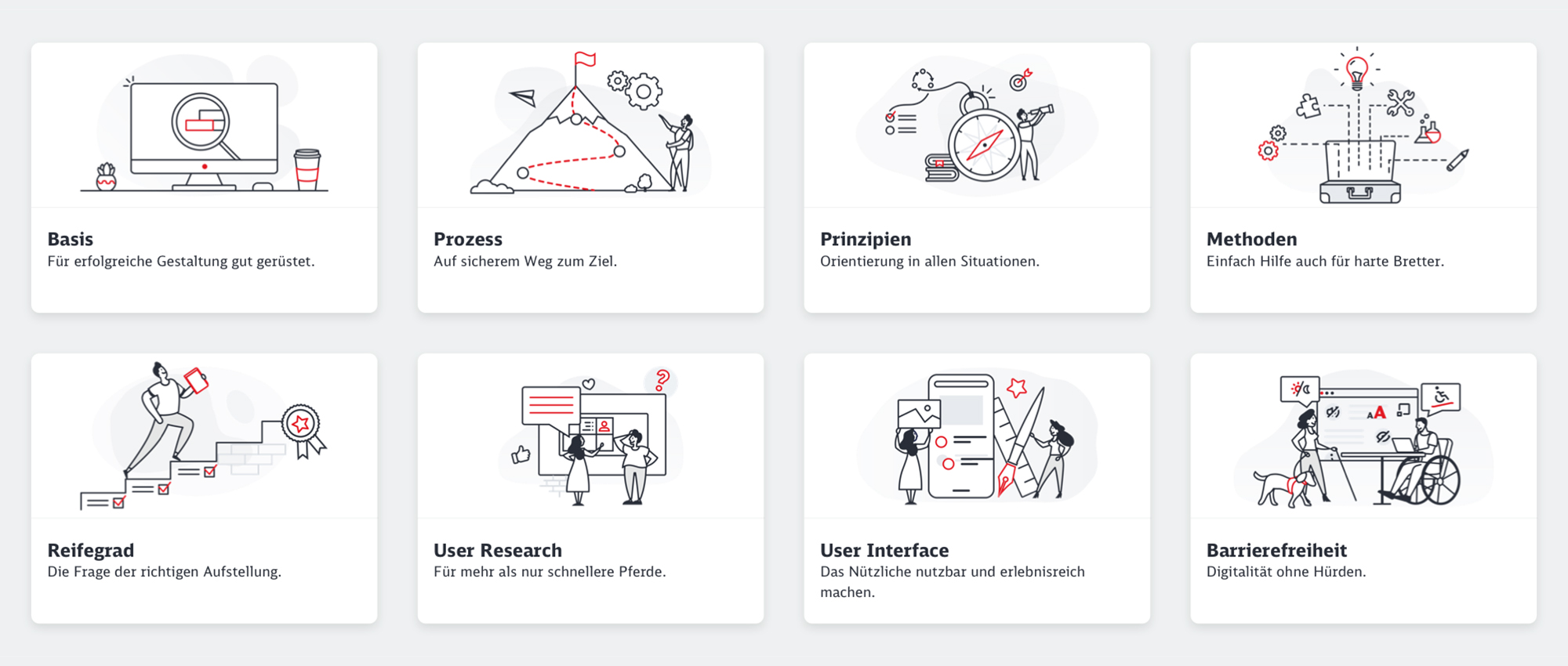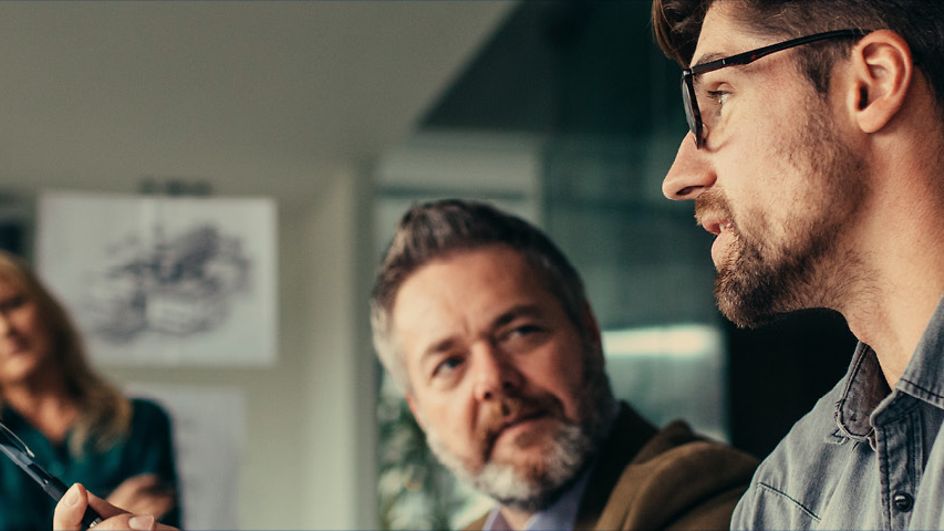Strategic UX enablement
Article: How Deutsche Bahn's digitalisation strategy puts people centre stage
06/2024 – In complex organisations like Deutsche Bahn, systems and applications have traditionally been developed with a strong focus on technological requirements. DB Systel is working with DB Fernverkehr AG and DB Cargo to find ways of integrating the user's perspective into projects from the very start.
Before a clean, serviced and fully staffed passenger train can pull into the departure station, or a freight train with the right containers can set off on its journey, several complex processes have to mesh together flawlessly. The IT systems and applications at the heart of this technical, highly complex environment are primarily designed to support operational processes and ensure safety, security and reliability.
"We often consider issues from a purely technical or engineering perspective," says Tobias Schoenmüller, Senior Service Experience Design Manager at DB Fernverkehr: "while forgetting that people – like drivers, dispatchers and on-board service staff – are a key part of digital transformation." The daily challenge faced by IT managers and software developers is to whittle the complexity of the railway system down to the essentials for users. DB Cargo and DB Fernverkehr are joining forces to address this challenge with effective strategies and tools.
"We are often very good at bringing business and IT together and optimising processes to come up with great technical solutions. But unless we take the focus on people just as seriously, we are unlikely to reap the promised benefits in the end."

Tobias Schoenmüller sees the "interplay between the perspectives of business, technology and people" as a key source of conflicting priorities in the day-to-day running of projects and asks: "Do people really play an equal role in development alongside business and IT?" This is where "service experience design" (SxD) comes into play at DB Fernverkehr AG. This is the expertise needed to design products and services that are as intuitive, accessible and appealing as possible for users while also meeting their needs and expectations. In other words, the expertise needed to deliver a great user experience.
Better user experiences ensure efficiency and save money
Struggling with solutions that do not feel intuitive and efficient is hard work, and it requires much more concentration or pre-existing knowledge to use an application that is not optimised for the context in which it is being used. This applies to both the solutions that passengers and customers use to interact with Deutsche Bahn and the apps and websites that DB employees work with on a daily basis. User satisfaction aside, there are other tangible benefits to putting the user experience in the spotlight. Goal-oriented solutions that are easier to use require less training and support, reduce errors and facilitate faster and smoother operational processes.
In a process-driven company like Deutsche Bahn, individual activities in many areas have a specified lead time to help keep projects on schedule. People-centred applications make it easier to achieve the desired goals. "It's not about turning people into better 'efficiency machines'," says Tobias Schoenmüller. It's about making it easier for people to do their job, which in turn boosts their job satisfaction. "And being happy at work has a positive impact on performance."
Putting the human perspective on an equal footing with business and technology
David Gilbert is Chief Consultant for Digital Design & UX at DB Systel. For years now, he has been involved in introducing the theoretical and practical aspects of human-centred design to the DB Group. Together with other experts at DB Systel, he provides support and designs solutions for various Deutsche Bahn business units to raise awareness of human-centred design and promote its implementation in day-to-day work.
Ideally, focusing on the user's perspective when designing and developing solutions should not be a separate step with a separate role, but a natural part of the development process. Every employee involved in the design of services and solutions should be aware of the context and the user's perspective. Good UX emerges as an overarching and continuous process that runs through all phases and tasks in the development of software or services.
That is why it is important for the CIO/CDO organisations of DB Cargo and DB Fernverkehr AG to hardwire the human perspective strategically – in a comprehensive and uniform way – into their business unit. DB Systel has been working with both business units on developing individual strategies and suitable tools to put human-centred development into practice company-wide. The result: railway-specific tools and pragmatic guidelines for the relevant business context.
"We are making sure that the human perspective is given its proper position and importance in the development of digital products and services."

A UX toolbox for DB Fernverkehr AG
David Gilbert and other DB Systel employees have been working in close partnership with Tobias Schoenmüller and his colleagues at DB Fernverkehr AG for around four years. During this time, they have jointly developed methods and tools specifically for the requirements of the Long Distance business unit: "We wanted to ensure that the human perspective was systematically established and professionalised in long-distance transport," says Tobias Schoenmüller, recalling the starting point for the partnership. From the outset, it was important to "customise this capability for our company and make it scalable – not simply impose it". "We started by developing a framework to introduce the concept of user experience to the organisation," recalls David Gilbert. "In other words, we devised ways of integrating it more effectively into the existing IT processes and identified the key principles that we could use as guidelines."
Tobias Schoenmüller adds: "We do this by empowering our colleagues in the right places." The information platform for service experience design (SxD) was established specifically for this purpose. It is a single point of contact where employees can find principles, methods, and tools such as templates for designing a good user experience at DB Fernverkehr AG. It provides suitable checklists, tools and common standards for every phase and aspect of service development. Whether you are a product manager, developer or designer – you will find the principles and methodological tools you need here.
"We also set quality standards for human-centricity in digital products and projects, for example, the UX maturity level," adds Tobias Schoenmüller. This UX maturity level and the capability model on which it is based are specially developed evaluation tools that make it possible to strategically manage the user experience of projects right from the start. And that is why the UX maturity level is now being used in a selection of strategic projects at DB Fernverkehr AG. Experts use a defined process to determine the maturity level in several phases of a project, recommend measures and then check the maturity level again.
Convenient access to complex rail freight transport
As digitalisation progresses, the user experience is also playing an increasingly important role in freight transport. Over the past few years, for example, DB Cargo has digitally transformed customer contact for its employees. In addition, companies now book a range of services themselves in many cases. IT and product managers also face the challenge of mapping complex operational business processes in intuitive digital systems. Freight transport services are for business customers only, and many of the companies and transport variations involved have their own requirements and processes – challenging conditions for digital tools.
"The co-developed UX strategy is a good starting point for us at DB Cargo to integrate key aspects into our IT development processes in the next step. This will ensure that we never lose sight of the user focus at any stage of development."

This is why DB Systel has recently developed a UX strategy for all digitalisation measures in collaboration with DB Cargo's IT Strategy, Architecture and Processes department. "This is happening at exactly the right time, as the issue of complexity is a major focus of our new IT strategy at DB Cargo," says Kevin Hoffmeister. He supports the implementation of DB Cargo's digitalisation strategy on behalf of the Management Board. "The basic idea behind this is to reduce the complexity of IT for employees and customers overall," says Kevin Hoffmeister. The user experience has therefore become a key component in the digitalisation of DB Cargo. In practice, this can mean, for example, reducing the number of different applications and in-house developments by using standard solutions on common platforms.
In the first phase of the collaboration, DB Cargo and DB Systel defined a vision and worked out different operational approaches to achieve it. The project team is currently working on how specific processes for user-centric services can be established and integrated into the digitalisation processes. The experience and methods gained from years of working with DB Fernverkehr AG were used as a template: "It's all about implementing the strategy with a good sense for the context in which the organisation is operating," says David Gilbert. With the result that the "UX Toolbox", for example, now offers DB Cargo employees the information and guidance they need for their everyday work – in a similar way to DB Fernverkehr AG's SxD platform.
At DB Cargo, too, the measures for ensuring a consistent UX are already having a direct impact on actual projects and are being integrated into the existing digitalisation processes. For example, UX has been an integral part of the current enhancement of the link2rail customer portal from the very start. "It's important not to hide necessary functions behind too many clicks," says Marina Ferrari, one of David Gilbert's colleagues in the project: "Instead, we use filter criteria and the systematic arrangement of elements – such as the search fields in the wagon overview – to speed up searching."
Working together to put users centre stage
DB Systel, DB Cargo and DB Fernverkehr AG are now engaged in an open exchange to advance the user experience for employees and customers, thereby strategically and sustainably improving the user-friendliness of IT applications within the DB Group. The domain-specific knowledge of DB Fernverkehr AG and DB Cargo perfectly complements DB Systel's methodical UX expertise and experience with corporate standards. The keys to success in practice are "partnerships, tools, knowledge transfer and expertise", says Tobias Schoenmüller. Kevin Hoffmeister concludes: "We are a large company and should continue to put our heads together to offer our employees and customers the best possible user experience."



